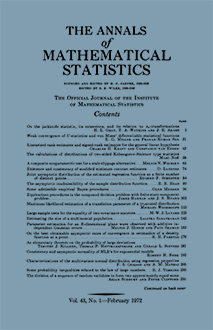Abstract
Using a stochastic approximation procedure $\{X_n\}, n = 1, 2, \cdots$, for a value $\theta$, it seems likely that frequent fluctuations in the sign of $(X_n - \theta) - (X_{n - 1} - \theta) = X_n - X_{n - 1}$ indicate that $|X_n - \theta|$ is small, whereas few fluctuations in the sign of $X_n - X_{n - 1}$ indicate that $X_n$ is still far away from $\theta$. In view of this, certain approximation procedures are considered, for which the magnitude of the $n$th step (i.e., $X_{n + 1} - X_n$) depends on the number of changes in sign in $(X_i - X_{i - 1})$ for $i = 2, \cdots, n$. In theorems 2 and 3, $$X_{n + 1} - X_n$$ is of the form $b_nZ_n$, where $Z_n$ is a random variable whose conditional expectation, given $X_1, \cdots, X_n$, has the opposite sign of $X_n - \theta$ and $b_n$ is a positive real number. $b_n$ depends in our processes on the changes in sign of $$X_i - X_{i - 1}(i \leqq n)$$ in such a way that more changes in sign give a smaller $b_n$. Thus the smaller the number of changes in sign before the $n$th step, the larger we make the correction on $X_n$ at the $n$th step. These procedures may accelerate the convergence of $X_n$ to $\theta$, when compared to the usual procedures ([3] and [5]). The result that the considered procedures converge with probability one may be useful for finding optimal procedures. Application to the Robbins-Monro procedure (Theorem 2) seems more interesting than application to the Kiefer-Wolfowitz procedure (Theorem 3).
Citation
Harry Kesten. "Accelerated Stochastic Approximation." Ann. Math. Statist. 29 (1) 41 - 59, March, 1958. https://doi.org/10.1214/aoms/1177706705
Information





